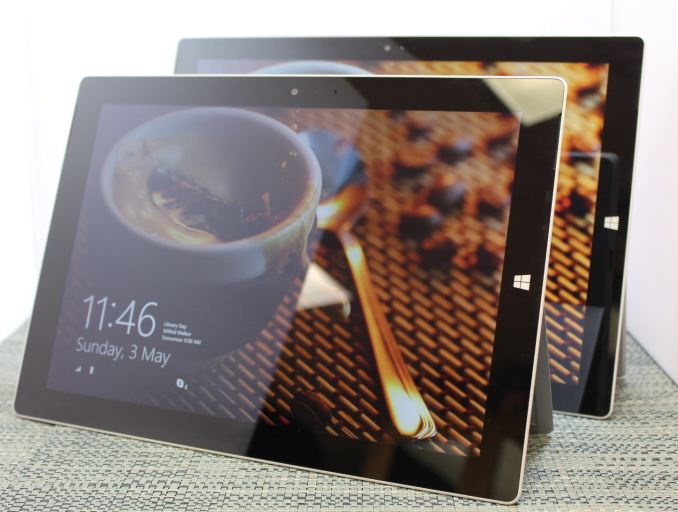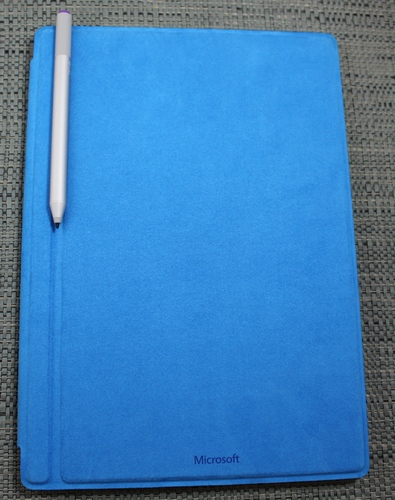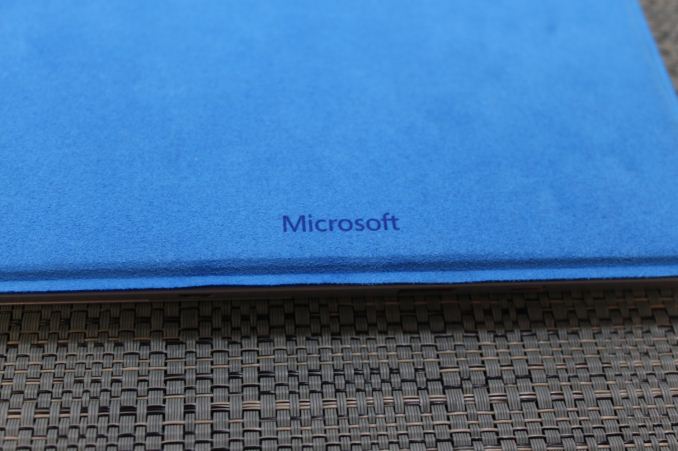The Surface 3 Review
by Brett Howse on May 4, 2015 9:00 AM ESTFinal Words
In the Windows space, there is quite a bit of variety in tablets. Some are well under $100, and some go over $1000. In this space, the Surface Pro 3 has done very well, establishing a name for itself with good performance in a small form factor. Microsoft is certainly trying to emulate this success with the Surface 3, and for good reason. With the Surface Pro 3, they got a lot right, so it makes sense to push the value line in the same direction.
The Surface 3 is superior to its predecessors in many ways. Where they were good, it is better. It keeps the wonderful magnesium chassis, but stretches it into a 3:2 aspect ratio. This alone is almost worth the price of admission, but it is just one of many changes made. I would argue that it is one of the most important changes to this tablet, and it makes it a better tablet and a better laptop. The kickstand has always been a staple of the Surface lineup, and adding the one additional step really helps make it even more usable in more scenarios. I wish it opened just a bit wider like the Pro model does, but that is a small gripe.
The move to x86 with the Atom x7-8700 was long needed. No longer is Surface and Surface Pro not able to run the same applications. Windows RT was always going to be a tough sell, but even more so since the Windows Store did not take off as quick as would have been necessary for RT to have a future. Once Intel shipped Bay Trail though, the writing was on the wall for Windows RT, since there was little reason to sacrifice the backwards compatibility of x86. The move to Cherry Trail in this model has provided a speed boost as well, and for light workloads it is more than sufficient. Plus, you could run anything that a Surface Pro could run, even if it will take a bit longer. That is an option that just did not exist before with the Surface line.
That being said, the SoC performance is where the price point dictates - around the good ARM products but poorer compared to Core. This is especially true when compared to the Surface Pro 3, but it is worth noting the SoC power draw between the two (14W vs 2W). That being said, the performance of the eMMC is a major drawback to how this device feels, especially in day to day use. Most of the time it isn't noticable, but when there is a bottleneck most of the time it was due to disk accesses.
From a long term usability standpoint, getting rid of the 32 GB model and having Surface 3 start with 64 GB is a big boost. 32 GB is a tough sell when you have the larger install footprint of Windows, as well as a recovery partition. Add in some Windows Updates, and a 32 GB model is going to be near capacity right away, and that really diminishes eMMC’s performance. Now the base model starts at 64 GB, and for just $100 more, you can opt for the 128 GB model which also has 4 GB of RAM. I personally think that would be $100 well spent, and if I was buying, that would be the model I would go for.
The accessories are also first rate. The keyboard is really quite good, and although the trackpad is small, it does work well when needed. It is a bit on the pricey side but it really does complete the Surface 3 and gives you the laptop capabilities in a nice cover. When I was using it as a tablet, I almost always removed the keyboard though, so it is certainly not a must have, but a really should have. Adding the pen to the lineup for this round was also a great move. Being able to use the Surface 3 for quick notes came in very handy, and I found the pen to be quite easy to glide over the screen, and accuracy was top notch. Of the accessories, the dock is likely not something the average consumer needs, but it really is a nice dock for storage and charging. At $199 though, it is too much for the average person to go for. For businesses though, it should come in very handy and should help the Surface 3 gain some traction there. It is not quite as good as the Surface Pro’s dock though, since this model lacks the proprietary docking port of the Surface Pro 3.
There is a lot to like about the Surface 3, but not everything is perfect. Battery life, especially when compared to other tablets, is well below average. This is despite having a display with a pixel density less than a lot of the competition, which means the Surface 3 should have an advantage in backlight power consumption. Display power draw is a huge concern, and perhaps the Panasonic one in the Surface 3 is not quite as efficient as others, especially Sharp’s IGZO lineup. The overall battery life is still decent though, and the much improved standby time is a big boon. However the charge rate is really a problem on this tablet, and it would have been excellent to see this new device embrace USB Type-C as the charging connector. Since it already has a full sized USB 3.0 port, there would be very little downside to moving to the new connector for charging, and it would allow for a reversible insertion as well.
I think though that the battery life is really the only real concern for the Surface 3. In the Windows space, there is no other tablet quite like this one, except maybe the Surface Pro 3, but that device is bigger, and heavier, and less useful as a tablet. It does have far more performance available, but for far more money up front.
Up to this point, I have not discussed the ability to use Surface 3 in your lap at all, and for good reason. For people out in the world that need to be able to use a device in their lap, then please just buy a notebook computer. Almost none of the 2-in-1 devices that I have tested have been especially good at that task, even those with true attachable keyboards. Only the devices like the Yoga 3 Pro which keep the processor in the base have the correct balance for this task. The Surface 3 can work in a pinch, but it is much better suited to be used on a desk with the keyboard attached if you need to use it as a notebook.
Pricing is the final piece of the puzzle. At $499, you get a decent spec with 2 GB of memory and 64 GB of storage. The $599 model bumps that to 4 GB of memory and 128 GB of storage. It is not inexpensive. Add in the keyboard for another $130 and the Surface 3 is getting close to the pricing of the ASUS UX305, which has a lot more performance available. The pen is another $50 on top. The base price of the Surface 3 is, I think, competitive, but adding in the accessories to really make it what it is advertised as ramps the price up in a hurry.
So with those caveats aside, we can finally get to the conclusion that you have likely guessed already. The Surface 3 is a great device. The build quality is really at the top level of any OEM out there. The form factor is finally the right one after two previous generations that got it slightly wrong. The weight is lighter than any previous Surface, and just as balanced. Performance of the x7 Atom CPU is great for light tasks, and if you need more than light tasks then this is not the device for you. As a tablet, it is great to use in either orientation, with the portrait mode being especially good now for browsing the web. The kickstand is improved, they keyboard is improved, the base tier steps up to 64 GB of storage, making it actually useful without immediately adding micro SD to the mix.
With Windows 10 right around the corner, the Surface 3 feels like Microsoft’s best attempt yet at creating a great tablet computer. If you in the market and you want a Windows 8.1 tablet, it would be worth your time to check out the Surface 3.













265 Comments
View All Comments
Luc K - Thursday, May 7, 2015 - link
Battery life of both Yoga 3 Pro and the Asus T300 Chi are not anywhere close to this one.Then again completely different kind of devices.
This Atom CherryTrail CPU is actually newer than Core M but different kind of line of CPU's obviously.
MattVincent - Tuesday, May 5, 2015 - link
The 64gb doesn't bother me but the 2gb of ram seems like its just cutting corners. Price goes up way to fast once you add on the accessories. They shouldn't be charging for the pen.TEAMSWITCHER - Tuesday, May 5, 2015 - link
Ya think? I just checked MacMall.com, and I can get a 2015 11" MacBook Air for $819. That includes an Intel Core i5 CPU with HD6000 graphics, a decent keyboard, industry leading trackpad, PCIe SSD, Thunderbolt port, 2 USB 3.0 ports, and MagSafe Power. The display on the Surface might be a little better, but the atom CPU and archaic storage are very more worse.I own an 2013 11" MacBook Air and have found it to be a very capable machine. The screen is small, but workable thanks to OS X's excellent full-screen app / virtual desktop implementation. When I'm in my office, I connect it to my 27" monitor, Apple Keyboard, & Magic Mouse and use it like any other desktop.
The Surface 3 possesses only one redeeming quality - a Pen. How bad are you willing to let Microsoft screw you over for a Pen? If the answer is "brutally" then buy a Surface 3.
xthetenth - Tuesday, May 5, 2015 - link
The screen isn't just small, it's wildly archaic with a low res and bad panel technology. I'd also love to see you try to use the air as a tablet. If you don't need a tablet, don't get a tablet, get an ultrabook.RafaelHerschel - Tuesday, May 5, 2015 - link
I considered a MacBook Air, but the screen was unacceptable at the price point. I'm sure that will be rectified in the future, but for now there are inexpensive Windows alternatives with much better screens.AnyOny24 - Wednesday, May 6, 2015 - link
If you want to talk about that price point you should talk about the Pro 3 core i5 which supports tablet mode / touch, the same pen you're talking about, bigger / better screen... silly comparison.damianrobertjones - Wednesday, May 6, 2015 - link
Or I can just buy the S3 along with a £20 BT keyboard.BlueBomberTurbo - Thursday, May 7, 2015 - link
Actually, the screen on the Surface 3 is the best portable screen you can get next to maybe the new Macbook. The Air's screen was terrible for anything requiring any level of color accuracy. You know, the artsy stuff that you can apparently only do on a Mac.The other redeeming qualities are its size and weight. I know I bought it specifically for those and the screen, as a portable workstation for my photography. When you cram lots of lenses and a couple camera bodies in your backpack, you're already hauling around a good amount of weight. A well-spec'd laptop certainly isn't going along for the ride, too.
lokhor - Tuesday, May 5, 2015 - link
Worst thing about the dock on the SP3 is that the angle cannot be adjusted so its virtually useless if you want to have it set up as a secondary screendigiguy - Tuesday, May 5, 2015 - link
Laughing out loud at the "bulky and heavy" comment. This tablet weights less than the ipad 4 and I was not hearing people call that bulky and heavy.... Better, this tablet has a whole inch more screen surface that the ipad.... But this is partly the fault of reviewers that call this a 10 inches device, like the ipad.... Why the ipad, that is 9.7 inches, is 10 inches and this one, at 10.8, is not 11 inches? Increase the screen size of the air and the weight will also go up, while still being a bit lighter, not to mention ipad 4 and below.I have a 600g 10.1 inches windows tablet and it feels very light and pleasant to hold with one hand, just awkward with its 16:9 ratio. The surface will feel more balanced.
Concerning storage speed, the 128GB model offers better performance (see this accurate review for more details http://www.notebookcheck.net/Microsoft-Surface-3-T...
Having said that, this is the performance with the encrypted SSD. Personally I decrypted the SDDs in all my tablets (Surface pro 3, HP Stream 8, etc.) and the performance, especially the sequential one, has significantly increased.